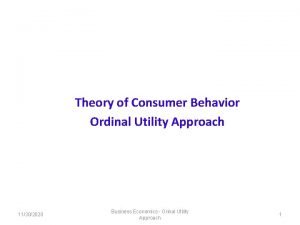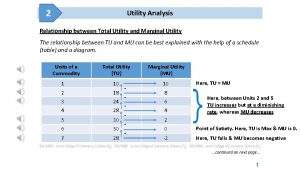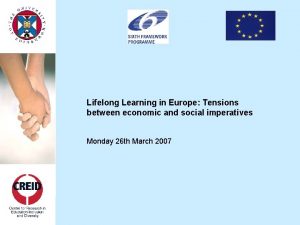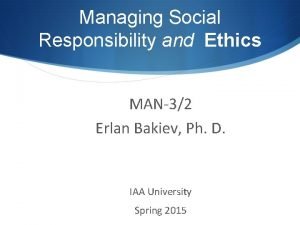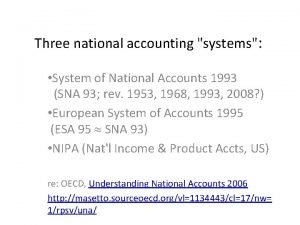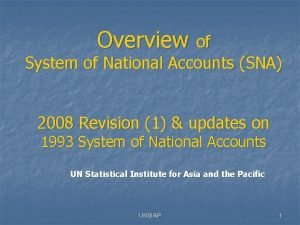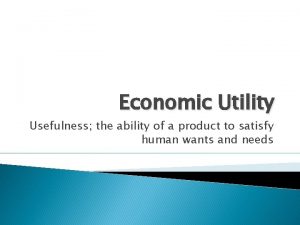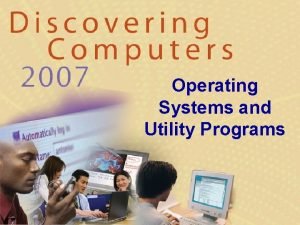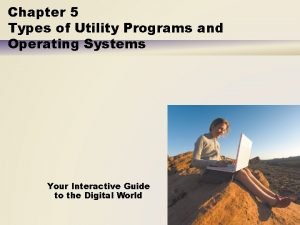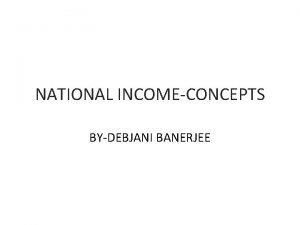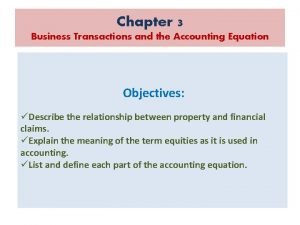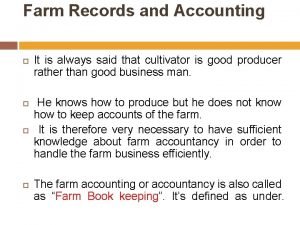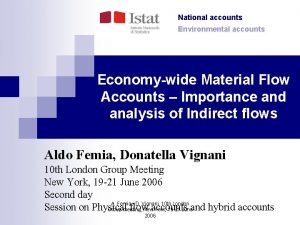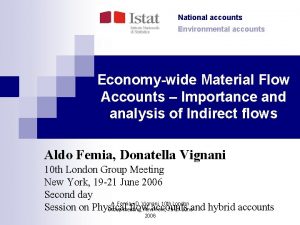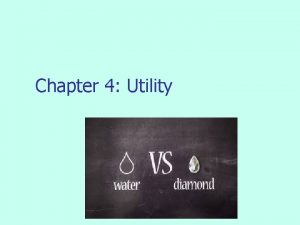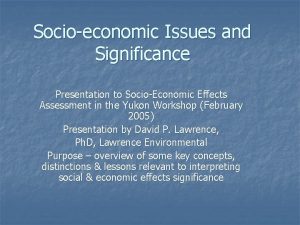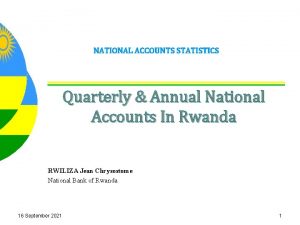National Product and National Utility Accounts of Socioeconomic










































- Slides: 42

National Product and National Utility: Accounts of Socio-economic Wellbeing from Time Budgets. Jonathan Gershuny Centre for Time Use Research Department of Sociology University of Oxford

Summary • Time budgets can be used to produce complete “extended national product” (e. GNP) accounts. • Time diaries can also be used to measure utility in the original (Bentham/Mill) sense. . . • . . . and used in turn to produce Gross National Utility (GNU) accounts. • e. GNP and GNU give different pictures of historical change in well-being.

Happiness, well-being & public purpose • • Durkheim: happiness object of ec. progress? Kahneman: subjective vs objective happiness Easterlin Paradox: happiness vs GNP…. …but why is the disjunction between growth and happiness surprising? • Krueger, Kahneman (2009) Nat. Time Accs. • Public policy implications: Stiglitz commission

Work and National Product • Third person criterion: – “work is any activity you can pay a third party to do for you without losing the benefit from it”. • Hence: – unpaid household work, volunteering. . . – These can substitute for paid work – “Extended National Product”

“…without losing the benefit…” • Refers to income or material product of the activity • …ie implies that there are no intrinsic satisfactions (or dis-satisfactions) in the conduct of paid and unpaid work. • A strong assumption… • Alternative: JS Mill “utility”: – Consumption & production both generate utilities alternative national accounts.

Chains of provision for wants • Human wants (food, shelter, care etc. ), met by a combination of activities. • Three “factors of provision”: – Paid work time – Unpaid work time – Consumption time • Technical change alters the balance among these.


A National Time Budget: UK adults, 1961 (minutes per UK adult aged 18+) UK time____________________ Non. UK leisure unpaid UK paid work time______ work Med, M’gers, Other Educ scientists Serv Manual total Sleep Shelter, nutrition Home leisure Out-Leis, shops Med & Ed 564 94 159 213 12 87 25 5 B’ground servs Exports TOTAL 963 196 15 32 83 150 1440 Imprt work

Input/output time budget construction • Associate each final commodity with one (or more) categories of want… • … multiply through by input/output coefficients to get value added by industry, plus imports and exports… • … treating investment as if intermediate outputs… • …then multiply through by hours of work by industry and occupation from LFS… Gershuny 2000 Chapter 5(? )

A National Time Budget: UK adults, 1961 (minutes per UK adult aged 18+) UK time____________________ Non. UK leisure unpaid UK paid work time______ work Med, M’gers, Other Educ scientists Serv Manual total Sleep 564 Imprt work 564 94 159 1 15 32 71 374 24 213 12 1 2 5 12 245 4 87 25 0 2 13 12 139 3 12 2 10 8 37 2 B’ground servs 1 5 13 17 36 1 Exported work 0 5 11 30 45 6 15 32 83 150 1440 40 Shelter, nutrition Home leisure Out-Leis, shops Med & Ed TOTAL 5 963 196

A National Time Budget: UK adults, 2001 (minutes per UK adult aged 18+) UK time____________________ Non. UK leisure unpaid UK paid work time______ work Med, M’gers, Other Educ scientists Serv Manual total Sleep 558 Imprt work 558 65 147 3 17 18 25 276 22 Home leisure 244 24 2 3 4 4 281 3 Out-Leis, shops 136 52 3 10 5 206 4 24 5 11 4 53 3 B’ground servs 2 8 10 6 25 1 Exported work 2 11 11 18 41 10 34 47 62 62 1440 43 Shelter, nutrition Med & Ed TOTAL 8 1011 224

GNP: non-exhaustive, input-based estimation • GNP = ∑(paid time*wages) Leisure, Unpaid Consumption work All UK time 1011 223 Paid work 206 All UK time 1440

Shift in paid/unpaid work balance All UK work time Minutes/day 1961 2001 Paid work time 281 205 Unpaid work time 186 224 total 477 429 Paid as % of all work 59% 48%

GNP extension: valuing unpaid work • Two methods: 1 Shadow wages – Assumes unpaid value=own marginal wage – values home-baked cake for brain surgeon at 10 times value of ditto for pastry chef 2 Shadow prices: – Either: specialist (eg taxi driver for school trip) – Or “housekeeper wage”

GNP and extended GNP, input-based • GNP = ∑(paid time*wages) • Extended GNP = ∑(paid time*wages) + ∑(unpaid time*shadow wages) Leisure, Unpaid Consumption work All UK time 1011 223 Paid work 206 All UK time 1440

Valuing consumption events • National accounting identity: – Value of production ≡ value of consumption • Alternative approach to extension: – Count consumption events in diary (meals, trips, outings, rests, nights’ sleep etc. ) – Use market prices for purchased instances – Use market-equivalent prices for home produced instances (eg taxis for car trips, hotel rates for nights sleep etc); subtract costs of inputs (rent, materials etc). (Luisella Goldschmidt-Clermont, Duncan Ironmonger, Sue Holloway)

Ext. GNP + nat. consump exhausts activity • Extended GNP = ∑(paid time*wages)+ ∑(unpaid time*shadow wages) ≡ • (Extended) National Consumption = Sum of actual or shadow values of every consumption episode Leisure, Unpaid Consumption work All UK time 1011 223 Paid work 206 All UK time 1440

UK National Product and Extended National Product Estimates (based on activity patterns of population aged 20 -65) Conventional Extended National Product Extended NP as % of Conventional NP 1961 100 164 1984 162 199 201 2001 295 334 185

Ext. GNP + nat. consump exhausts activity • Extended GNP = ∑(paid time*wages)+ ∑(unpaid time*shadow wages) ≡ • (Extended) National Consumption = Sum of actual or shadow values of every consumption episode • Exhaustive, BUT. . • value added focus implies no intrinsic welfare consequence from work • Hence need for more comprehensive indicator

Utility is not happiness • Happiness vs utility in Kahneman (1999): – “subjective happiness”== judgement of general affective state over a past interval (“Helen’s thoughts about how happy she was in March”) – “objective happiness” == instant enjoyment of the moment, recorded by diary or similar… – …“…an objective and normatively justified definition of ‘true’ well-being that is based on instantaneous utility” (p. 4).

Process benefits, utility, enjoyment • Utility: surveys of enjoyment of activities (JS Mill 1863) – “What is there to decide whether a particular pleasure is worth purchasing at the cost of a particular pain, except the feelings and judgement of the experienced? ”…“What means are there of determining which is the acutest of two pains or the intensest of two pleasurable sensations, except the general suffrage of those familiar with both? ” (Utilitarianism Chapter 2) • Process benefits (Juster and Stafford 1984) • “joint production” with national output • ∑(time in activity * questionnaire-based enjoyment measure) • National Time Accounts (Krueger and Kahneman 2009) • ∑(time in activity * diary-based enjoyment measure)

Affect time diary studies • Robinson 1985 US open-coded selfcompletion diary, start/end intervals, with enjoyment scale 0 -10 • Erlich UK 1986 pre-coded selfcompletion diary, fixed 30 -minute slots, converted to start/end with terminal affect score, enjoyment scale 5 -1, recoded 2*(5. 5 - enjoyment score)

USA enjoyment scores, 95% confidence intervals 9, 00 8, 50 8, 00 7, 50 7, 00 6, 50 6, 00 5, 50 out-home sleep & other leisure personal home care leisure tv child care MEAN paid work travel shopping unpaid work

Men’s and women’s enjoyment of activities

Utility estimation: analysis strategy • Start with a “case=event” file… • …attach to each event of a particular activity type, aggregate estimates of total time devoted by diarist to that activity during the diary day… • …weight each event by its duration and… • …regress total time, total time squared, and controls onto measured enjoyment of the event.

Utility from one type of activity Eq 1) eij = ajk. X + 2 bjtj +cjt j Marginal utility for an activity Eq 2) δeij/δtj =bj+2 cjtj Total utility for the observation period Eq 3) u = (∑ 1 i∑ 1 j dij. eij )/T Where: – – – eij is the enjoyment rating of each diary event dij is the duration of each event i events in a continuous diary sequence j exclusive categories of activity (eg “sleep”, “watching television”, “paid work”) X a vector of k control variables tj total all time devoted by diarist to activity j over the entire period. Estimate from j separate equations (one for each activity)

OLS regressions. Dependent : enjoyment ratings 11 point ( 0 -10) scale for US, 5 point (1 -9) scale for UK, p<. 05 in bold Other controls not shown: age, age sq, employed fulltime, has cores. partner, youngest child aged <5, youngest child aged 5 -15, complete sec'ry ed, some tertiary educ, log hourly wage US (1985) Multiple R Mins in activity/100 Mins acty sq/10000 leis out other home pers. leis care 0. 24 0. 12 0. 06 0. 31 0. 30 paid dom work shop child care travel 0. 15 0. 16 0. 09 0. 22 0. 26 0. 25 -0. 07 0. 05 0. 09 0. 24 -0. 08 -0. 18 -0. 02 -0. 03 -0. 02 tv 0. 14 0. 02 -0. 01 0. 65 0. 08 0. 03 UK (1986) Multiple R 0. 17 0. 20 0. 19 0. 21 0. 24 0. 28 0. 29 0. 23 0. 26 Mins in activity/100 0. 25 0. 35 0. 49 0. 48 -0. 08 0. 00 1. 16 0. 47 0. 19 Mins acty sq/10000 -0. 02 -0. 04 -0. 06 0. 02 -0. 16 -0. 10 -0. 01




Correspondence in UK/US “marginal utility=0” points

Counterfactual experiment • Estimate joint UK-US utility equations… • . . . standardise for each sex (mean=0, sd=1). . . • …then use coefficients to impute aggregate utility for various MTUS surveys for a range of periods and nations. • Interpret result as answering: – “What would be the utility consequence if a population of Anglo-Americans had Nordic or Corporatist or Southern time budgets and other socio-demographic characteristics? ”

Multinational Time Use Study: 50 surveys, 20 countries, 550 K days

National Time Value Accounts (GNU): Nordic countries 0, 5 Nordic men Denmark 0, 4 Sweden 0, 3 Nordic women 0, 4 0, 3 Norway 0, 2 Finland 0, 1 0, 2 0, 1 0 1975 -84 1985 -89 1990 -94 1995 -99 2000 -4 0 1975 -84 -0, 1 -0, 2 -0, 3 -0, 4 1985 -89 1990 -94 1995 -99 2000 -4 Denmark Sweden Norway Finland

National Time Value Accounts (GNU): Corporatist countries 0, 5 Corporatist men 0, 4 Corporatist women France 0, 4 Netherlands 0, 3 Germany Austria 0, 2 Slovenia 0, 1 0 0 1975 -84 -0, 1 0, 3 1985 -89 1990 -94 1995 -99 2000 -4 1975 -84 1985 -89 1990 -94 1995 -99 2000 -4 -0, 1 -0, 2 -0, 3 -0, 4 France Netherlands Germany Austria Slovenia

National Time Value Accounts (GNU): Anglophone countries 0, 5 Anglophone women Anglophone men 0, 4 UK USA Canada Australia 0, 3 0, 2 0, 4 0, 3 0, 2 0, 1 0 0 1975 -84 1985 -89 1990 -94 1995 -99 UK USA Canada Australia 2000 -4 1975 -84 -0, 1 -0, 2 -0, 3 -0, 4 1985 -89 1990 -94 1995 -99 2000 -4

National Time Value Accounts (GNU): Southern countries 0, 1 Southern men and women 1999 -2001 0, 05 0 men women -0, 05 -0, 15 -0, 25 -0, 3 Italy Spain

Different time-use patterns, different evolution of GNU • NORDIC: above the mean GNU: women rising substantially. • CORPORATIST: both sexes converging on the mean. • ANGLOPHONE: both sexes falling below the mean. • SOUTHERN: men above the mean, women well below it.

Explanation? • Seems to be reasonably straightforward: – Growth in total work time in Anglo countries. . . –. . . shift from paid work to unpaid work. – Women in Southern countries left with disproportionate share of the unpaid work. – Women in the Nordic countries have smaller, fairer share of the unpaid work

Lesson for public policy: • Economic growth can reduce “objective happiness” • Shorter working hours, more (paid employment) childcare support to reduce unpaid work, fairer sharing between men and women could both encourage growth and increase happiness.

Summary • Difference between National Income and National Utility. • Both derived from time budget tables. • Utility measures derived from diaries. • Counterfactual utility analysis. → Policy conclusions

References J Gershuny 2000 Changing Times: Work and Leisure in Post Industrial Society, Oxford: Oxford University Press. J Gershuny 2012 “National Utility: measuring the enjoyment of activities” European Sociological Review doi: 10. 1093/esr/jcs 077 Luisella Goldschmidt-Clermont, 1999 Households Non-SNA Production: Labour Time, Value of Labour and of Product, and Contribution to Extended Private Consumption. Review of Income and Wealth 45(4), 519 -529. Holloway, Sue, Sandra Short & Sarah Tamplin. 2002. Household Satellite Account: (Experimental) Methodology. London, UK: Office for National Statistics. Duncan Ironmonger, 1999 Counting Outputs, Capital Inputs and Caring Labor: Estimating Gross Household Product. Feminist Economics 2(3), 37 -64. Tom Juster and Frank Stafford 1984 (eds), Time, Goods and Well-Being, Ann Arbor: Institute for Social Research. Danny Kahneman 1999 “Objective Happiness” in Well-Being: The Foundations of Hedonic Psychology eds DI Kahneman, E Diener and N Schwarz, New York: Russel Sage Foundation, pp. 3 -25. AB Krueger, D Kahneman, D Schkade, N Schwarz and AA Stone 2009 “National Time Accounting: The Currency of Life” in AB Krueger (ed) Measuring the Subjective Wellbeing of Nations: National Accounts of Time Use and Well-Being, University of Chicago Press/NBER, pp 9 -81.
 The national income and product accounts
The national income and product accounts Budget constraint
Budget constraint Relation between marginal utility and total utility
Relation between marginal utility and total utility Socioeconomic model
Socioeconomic model Socioeconomic examples
Socioeconomic examples Status fridge
Status fridge Ethical issue intensity example
Ethical issue intensity example Gdp 519
Gdp 519 York national accounts
York national accounts Systems of national accounts
Systems of national accounts Sna 2008
Sna 2008 Advisory expert group on national accounts
Advisory expert group on national accounts New product development and product life cycle strategies
New product development and product life cycle strategies What is a firm
What is a firm Types of product line
Types of product line Product/service desirability examples
Product/service desirability examples Contoh produk gabungan dan sampingan
Contoh produk gabungan dan sampingan Core product actual product
Core product actual product Cross product vs dot product
Cross product vs dot product Overview definition
Overview definition Contoh soal dot product dan cross product
Contoh soal dot product dan cross product Actual product adalah
Actual product adalah Dogld
Dogld Perkalian silang vektor
Perkalian silang vektor Time utility examples
Time utility examples Network operating system examples
Network operating system examples Types of utility software and their functions
Types of utility software and their functions National unification and the national state
National unification and the national state Difference between gdp gnp
Difference between gdp gnp Ap human geography unit 3 vocab
Ap human geography unit 3 vocab Tatlong pamamaraan ng national income accounting
Tatlong pamamaraan ng national income accounting Nostro vostro and loro accounts
Nostro vostro and loro accounts Administer subsidiary accounts and ledgers
Administer subsidiary accounts and ledgers Secondhand account
Secondhand account Departmental p&l
Departmental p&l Chapter 3 business transactions and the accounting equation
Chapter 3 business transactions and the accounting equation Accounts receivable and inventory management
Accounts receivable and inventory management Accounts payable tips and tricks
Accounts payable tips and tricks 2 1 checking accounts
2 1 checking accounts Farm records and accounts
Farm records and accounts Debtors control account
Debtors control account Chapter 20 patient collections and financial management
Chapter 20 patient collections and financial management Ocga 30-10-2
Ocga 30-10-2

